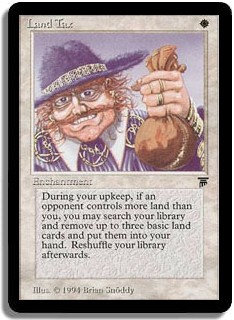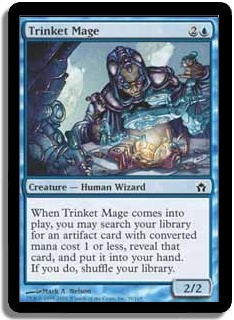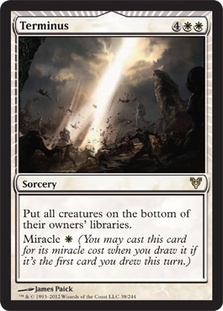“What’s the best deck for Land Tax?”
This was the heated question two weeks ago, when the card became unbanned in Legacy. Those with long memories thought back to Land Tax being used with Zuran Orb, Scroll Rack, Mox Diamond, and Empyrial Armor. Those with creative minds thought of combining Land Tax newer cards like Seismic Assault, Chrome Mox, Knight of the Reliquary, and Solitary Confinement.
“What’s the best deck with Land Tax?”
This is the much more important question. Land Tax is a great card; it is not a great strategy. The reason the card could safely be unbanned is that it’s slow. It doesn’t contribute to ending the game quickly, and it doesn’t protect you from being killed quickly. My golden rule for Legacy decks is that you need to be able to protect yourself starting right from turn 1 because decks like Reanimator, Dredge, and Storm often do not give you more than that. In such a format, what place does searching your library for basic lands have?
Land Tax is a great tool; it is not a great strategy. Zuran Orb, Scroll Rack, Empyrial Armor, and Seismic Assault are bad cards (by Legacy standards), and there are two major costs to putting them in your deck. The first is that your deck will not perform well in the games where you fail to quickly activate Land Tax. The second is that your strategy will be inherently flawed against combo because of how long it takes you to get going. Perhaps you can correct these weaknesses with extreme sideboarding, but you’re likely making things more difficult than they need to be.
But Land Tax is a powerful card. It’s not difficult to meet the criteria to make it a useful tool. You should have a minimum number of basic lands (I’d say five before Tax begins to be a consideration), and you should be playing a matchup where the winner won’t be decided in the first four turns of the game. Beyond that, you don’t need to put in much more work! Triggering Land Tax even once makes it well worth its slot.
Creatures (2)
Planeswalkers (4)
Lands (20)
Spells (34)

This is the deck that my brother, Ian, and I played last weekend at Grand Prix Atlanta. Ian finished in 27th place and while I fell short of making Day 2, it turned out to be a blessing in disguise (maybe) as I won a SCG Super IQ tournament with the deck on Sunday. Between the two of us, our record in matches played was 19-5-2. For the purposes of evaluating the deck, it’s best to count the two unintentional draws as losses, but even doing so, the win rate is a respectable 73% with room for improvement.
More than anything, this is not a “Land Tax deck,” but simply a deck that contains Land Tax. For our Grand Prix decklist, we failed to follow the advice I’ve given above and registered a Zuran Orb. While situationally useful, the Orb was not worth the slot and I changed it to a second Relic of Progenitus for Sunday’s Invitational Qualifier. Beyond that, our concessions to Land Tax were four maindeck Dazes and a very conservative land base.
Popular opinion is that Daze is not playable in pure control decks. One could argue that you want to make every land drop and that you don’t want dead cards in the late game. Perhaps it’s the Natural Order player in me speaking, but I would offer this noobish counterargument: Daze is awesome! It’s a much better card than Spell Pierce, and opponents won’t know to play around it since decks that look like this one rarely have it in their 75. The fact that turn 1 Tundra, Land Tax, Daze is close to unbeatable is icing on the cake!
Even if you reject Land Tax and decide to play a more stock U/W Control deck, please take away the lesson of the “Land Tax mana base.” A key to the success of this archetype is being able to reach four, five, and six mana without your more aggressive opponents Wastelanding you back to 1997. This deck can operate entirely on basic lands if need be. There are no colorless “value lands” because you simply don’t need them. Wasteland could be a useful late game tool, especially for killing annoying lands like Academy Ruins, but you rarely want to trade your lands one for one, so it’s not necessary. Mishra’s Factory could pressure opposing planeswalkers and sometimes trade on defense, but again, you can’t take full advantage of it because chip damage doesn’t matter. Karakas is probably the best consideration, but three non-blue lands is the number I’m comfortable with and you need a minimum number of basic Plains. Karakas opens you up not only to Wasteland but also to opposing Karakas’ legend ruling.
The Decklist
The reasons for Land Tax are mostly covered above, but it’s worth noting how it subtly changes the construction of the mana base. You can basically count Land Tax as a mana source since it’s quite convenient to have it while you’re mana screwed. The caveats are that you cannot go too low on turn 1 white sources (my suggested decklist has fourteen) and that you need to have enough lands in your deck to operate when you sideboard out Land Tax. It should come out against combo decks and be trimmed to one or two copies against RUG Delver.
We settled on three copies of Land Tax because it’s a card that’s very nice to see in your opening hand, but it’s bad to draw in multiples. The deck doesn’t revolve around it, so there’s no need for the full four. Although this deck is pretty good at shuffling away dead cards in the late game, it’s still painful to get clogged with them.
I don’t recommend maindecking Snapcaster Mage or Vendilion Clique because while their abilities are useful, you can’t make very good use of the bodies. Given that, they’re a little too overpriced and inefficient for a deck that’s already so strong in the late game. Trinket Mage, however, is a very welcome addition. It fills a hole in the mana curve (and Counterbalance curve), provides one extra way to shuffle, and offers some much needed card advantage and flexibility.
It may seem inconsistent to refer to Trinket Mage as card advantage while also saying that Snapcaster Mage’s body is irrelevant. The difference, however, is that Trinket Mage often searches for Relic of Progenitus, which means that he can fight Nimble Mongoose, Tarmogoyf, or even Knight of the Reliquary in combat rather than just chump blocking.
Relic started as a one-of Trinket Mage target, but I soon realized that I wanted to draw it naturally in nearly all matchups. It pumps down graveyard creatures, turns off Snapcaster Mage, annoys Lingering Souls, and protects you from Surgical Extraction. Extra game 1 percentage points against Dredge and Reanimator are certainly welcome as well. Relic also fits the deck nicely in the way it can manipulate the top of your library at instant speed for Counterbalance and miracles. Finally, the seven-card maximum hand size is surprisingly relevant for this deck, so the ability to “invest” a card into a permanent is helpful.
Counterbalance is often not a maindeck card in U/W Control, but I feel it deserves its slot. It’s nice having a few proactive plays in a deck that is mostly reactive. If your opponent has a slow start or stumbles in some way, you actually have a chance to take advantage by establishing your Counterbalance lock. My favorite thing about the card, though, is that your opponents are obliged to counter it. It draws a Force of Will so often that I’ve privately begun thinking of it as a blue Hymn to Tourach.
The finishers—Jace, the Mind Sculptor and Entreat the Angels—are chosen to make opposing spot removal dead. Jace is a natural fit, as he’s incredible with both Land Tax and miracles.
The Sideboard
Spot removal is all but dead in game 1, so your opponents would have to be very foolish (either that or very smart) to leave in their spot removal after game 1. This is the logic behind including Her Grace, Queen Baneslayer Angel, in the sideboard. Yes, five mana is a lot in Legacy, but she cannot be Spell Pierced, Elemental Blasted, Gaddock Teeg’d, or Thalia’d and since U/W Control has no Forests, she cannot be Submerged. Creature decks have little hope of racing her, and she can even give a hard time to some combo decks. A much-forgotten line of text gives her protection from Griselbrand, which means your opponents cannot gain life by attacking with him. They’ll likely have very few ways to get her off the board, so she can sometimes buy you a lot of time and sometimes lock them completely out of the game in combination with a well-timed Force of Will.
The fourth Terminus is a must, as it’s amazing against anyone who’s trying to kill you with creatures. One thing to be careful of, though, is Gaddock Teeg. Maverick has almost no chance of beating you if they cannot stick a Gaddock Teeg, but you have almost no chance of beating them if they can. Watch out for Mother of Runes, Cavern of Souls, and Karakas protecting him. The two extra Path to Exiles help a little bit with the Teeg problem.
I also bring in Grafdigger’s Cage against Maverick. It only really affects Green Sun’s Zenith, but since Gaddock Teeg is such an important card, I think it’s worth the slot, especially on the play. Cage, Tormod’s Crypt, and Pithing Needle are extra Trinket Mage targets for the appropriate matchups. Needle is especially good, as it’s a very versatile sideboard card in a very diverse format. Naming Griselbrand means that all of your creature removal can deal with him at no loss of card advantage.
Vendilion Cliques and Spell Pierces offer a little extra help against combo and control. Vendilion is the best card for a U/W mirror as you don’t need to tap out on your main phase and it’s very good against Jace, the Mind Sculptor. The only thing keeping me from playing more copies is that the most popular U/W deck splashes for Lingering Souls, which matches up well against Clique.
Finally, Oblivion Ring, Disenchant, and Blue Elemental Blast are your answers to hard to deal with permanents. Most specifically, they take care of Choke and Sulfuric Vortex, which are fairly insurmountable if they stick. Thankfully, though, each card has a variety of uses and will definitely pull its weight over the course of a long tournament. Oblivion Ring is very welcome as one more answer to Jace and Gaddock Teeg.
Gameplay
This is certainly a challenging deck to pilot, and a full article could only scratch the surface regarding the gameplay of U/W Control. However, I can offer a few choice pieces of advice to give you an idea of what should be on your mind as you play.
- You need to play fast! You also need to pressure your opponents to play at a fair pace. You’ll be at risk of going to time in every match that goes to three games and even in many that end 2-0. What makes this deck especially difficult is the way its complexity combines with clock pressures, meaning you cannot stop to think about every detail of every play. A certain amount of physical dexterity is helpful; the less time you can waste on shuffling and manipulating your cards, the better off you’ll be.
- U/W Control is at its heart a reactive deck, and there’s no single card that your strategy revolves around. It’s okay for your early Land Taxes and Sensei’s Divining Tops to get countered, and it’s okay for your Counterbalances and Jaces to get Force of Willed. Take two-for-ones whenever they present themselves. It’s best to play your spells with two mana open in the mid and late game, because it will force your opponent to use a Spell Pierce and another card to counter them. Don’t play around Mana Leak until you’ve seen it.
- Be aware of the seven-card maximum hand size. There are some times when you should Land Tax for the maximum and then discard with the goal of thinning your deck. There are other times, like in control mirrors where you might activate Land Tax multiple times, where the lands are better off in your library than in your graveyard. In such cases, plan things out before you decide how many lands to search for and end your turn with seven cards. Relic of Progenitus and Sensei’s Divining Top can be used to effectively increase your maximum hand size by sitting on the table until you need them, then cashing in for an extra card.
- You don’t need to rush to Jace’s ultimate. Once you have Jace in play for a few turns, the game is practically won, so find the cards you need to stop it from slipping out of your reach. That said, fatesealing yourself should be a common play. You often have knowledge of the top of your library, so sending a dead card to the bottom is not far off from drawing an extra card. You don’t always know what your opponent is looking for, but you always know what you’re looking for. Beyond that, it’s very easy for your opponent to simply leave a fetchland uncracked to counteract your fateseal.




